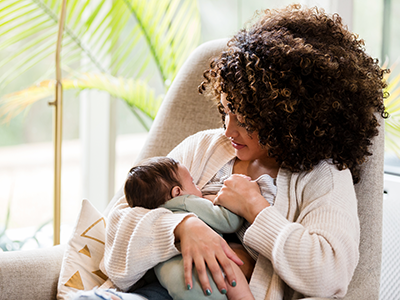If you feel like you’re producing more milk than your baby can drink—or your little one seems fussier or gassier—you may be experiencing breastmilk oversupply. Though some parents appreciate an abundant supply, oversupply can cause discomfort and feeding challenges for both of you.
Signs you may be an oversupplier
Symptoms of breastmilk oversupply can include:
- Choking, coughing or pulling on and off during feeds
- Clamping down or biting to slow the flow of milk
- Frequent spitting up
- Always appearing hungry and unsatisfied despite large weight gain
- Unwillingness to nurse to sleep
- Breast refusal
- Faltering weight gain due to feeding issues
- Colicky or gassy behavior
If your baby is thriving and feeding comfortably, you may not need to make changes. But if feeding is disruptive or uncomfortable, here are proven strategies to regulate your supply.
Why oversupply happens
Oversupply may stem from a strong letdown reflex, hormonal cues overproducing milk, pumping schedules that overstimulate or unfamiliar feeding routines like scheduled feeds or switching breasts too often. Typically, milk production is based on supply and demand — more removal signals the body to make more milk — but oversupply can result if this balance is disrupted. For general breastfeeding benefits — like immune support for baby and reduced cancer risks for parents — see Breastfeeding benefits, tips and advice.
How to manage a fast letdown
A fast letdown can be one sign of oversupply. When this happens, babies may struggle to latch and coordinate sucking/swallowing. To ease feeding:
- Express a small amount of milk before latching to soften the flow
- Allow your baby to come off the breast periodically to catch their breath.
How block feeding helps regulate supply
Block feeding is a technique that aims to regulate milk production by signaling the brain to produce less milk overall. Instead of alternating breasts every feeding, feed exclusively from one breast over several hours (e.g., 3–4 hours), then switch to the other. This reduces stimulation and slows production. Make sure to try this only after the first month postpartum, when supply is established — and ideally with guidance from a lactation consultant.
When to reach out for help
If your baby’s weight gain stalls, feeding is persistently uncomfortable or you’re dealing with recurring plugged ducts or mastitis, consult a lactation consultant or your pediatrician promptly to ensure both your comfort and your baby’s wellbeing.
 https://riseandshine.childrensnational.org/wp-content/uploads/2025/12/Mom-nursing-feature.jpg
300
400
Rise and Shine
https://riseandshine.childrensnational.org/wp-content/uploads/2017/11/childrens_riseandshine_logo.jpg
Rise and Shine2025-12-04 11:29:032025-12-04 11:29:03Tips for surviving your first month of breastfeeding
https://riseandshine.childrensnational.org/wp-content/uploads/2025/12/Mom-nursing-feature.jpg
300
400
Rise and Shine
https://riseandshine.childrensnational.org/wp-content/uploads/2017/11/childrens_riseandshine_logo.jpg
Rise and Shine2025-12-04 11:29:032025-12-04 11:29:03Tips for surviving your first month of breastfeeding
















Leave a Comment
Want to join the discussion?Feel free to contribute!